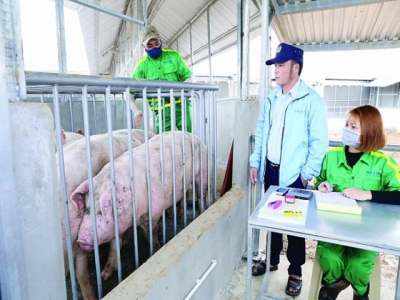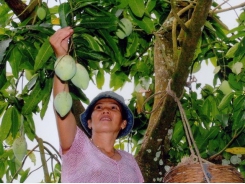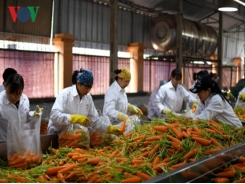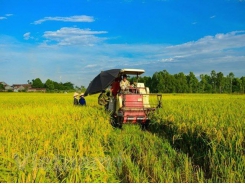Livestock attempts to overcome CPTPP wave

With the Comprehensive and Progressive Trans-Pacific Partnership Agreement (CPTPP), Vietnam's livestock industry is recognized as having to face more and more challenges rather than opportunities. In order not to be submerged, efforts to change, formulate a professional livestock foundation, improve productivity, quality and lower costs are the only direction for the whole industry.
Professionalizing, improving productivity and quality are important solutions to help the livestock industry overcome difficulties. Photo: Nguyen Thanh
Strong pressure
On January 14, CPTPP officially took effect with Vietnam. While many industries such as footwear, textiles ... are happy to receive opportunities from CPTPP, the livestock sector is in contrast, still cultivated with a series of worries.
According to the Multilateral Trade Policy Department (Ministry of Industry and Trade): In terms of goods, some types of agricultural products in some CPTPP countries have advantages, such as pork and chicken, which are Vietnamese products that can be produced, but competitiveness is still weak. The Minister of Agriculture and Rural Development Nguyen Xuan Cuong has recently emphasized: "CPTPP is officially in effect, Vietnam's agriculture faces a great risk of injury, typically the livestock sector when CPTPP member countries like Chile, Canada, Australia, New Zealand are rated as the most advanced and leading in the world. If the market protection is not improved in the context of deep integration, the situation will be very tough, not favorable as in 2018."
According to Mr. Nguyen Xuan Duong-Acting Director of the Department of Livestock Production (Ministry of Agriculture and Rural Development): When participating in CPTPP, putting on balance to compare opportunities and difficulties with the livestock industry, the rate is still inclined to difficulties with about 60 % (favorable factor is only 40%). In particular, among the member states of CPTPP, Vietnam will face disadvantages with beef and dairy products from countries with superior breeding levels such as Canada, Australia and New Zealand. "One of the biggest difficulties now is that the number of small farms participating in Vietnam's livestock industry is too large, with nearly 8 million poultry households, 3 million pig raising households and about 2 million households raising cattle and buffaloes, which makes it difficult to apply science and technology, especially high technology to reduce costs and improve product quality. The livestock sector is still loose, causing the livestock industry to be potentially unsustainable," said Duong.
Further analysis of the challenges and difficulties facing the livestock industry with the CPTPP, Mr. Nguyen Thanh Son, and Chairman of the Vietnam Poultry Association acknowledged: Vietnam's labor productivity is too low. While livestock farms with a scale of 1,000 children in the US have only 1-2 workers, in Vietnam there are over 20 employees. In addition, factors such as epidemics, food hygiene and safety, environmental pollution ... are also significant challenges for Vietnam's livestock sector. "It is easy to see that livestock products from some countries such as Australia, Canada, Mexico and Malaysia will enter Vietnam more when the import tax drops to 0% according to the CPTPP schedule. Meanwhile, markets like Japan, Australia, New Zealand ... have relatively high technical barriers, want to reach and expand export markets, Vietnam's livestock products need to overcome technical barriers as well as quarantine measures, hygiene and food safety, " Mr. Son said.
Formation of professional breeding
With the "heavyweight" competitors that are strong in livestock in the CPTPP sector, the pressure on Vietnam's livestock industry is quite obvious, but not necessarily the case that Vietnamese livestock will be easily submerged. According to the analysis of the Ministry of Industry and Trade: With two the items of pork and chicken, Vietnam has engaged in a relatively long implementation schedule (with some types of chicken being over 10 years). This is a much longer route than Vietnam's commitment to open the market in ASEAN, which is also very competitive in producing some types of meat. In addition, some experts see, in the short term, the consumption habits of Vietnam are mostly fresh meat, coming here will be cool meat. The domestic market for livestock products in Vietnam still has a great opportunity to compete against frozen meat imported from abroad.
In response to the question of how to improve competitiveness, help the livestock industry overcome "waves" of CPTPP, Mr. Duong points out: In the coming years, there is no other way but to gradually reduce the number of households: raising, increasing scale / household, coupled with production association. Specifically, in addition to the establishment of associated production organizations for farm households such as cooperative groups, cooperatives, it is necessary to take the core of large enterprises as the leading companies, with the connection between enterprises and cooperatives. . "How will the livestock sector only include livestock enterprises and professional livestock farms? The livestock units must produce products with the highest productivity, good quality, low cost. The remaining stages such as slaughtering, consumption and processing connections ... will be taken care of by professional enterprises and cooperatives, in fact, this is the direction that in the past years the livestock industry has been taking. In addition, in terms of common ground, Vietnam's livestock productivity is still lower than that of some advanced countries in the world, so this is also an aspect to note. Fight for improvement, improve competitiveness, " Mr. Duong said.
From the perspective of Vietnamese livestock enterprises, what does Mr. Son say about livestock companies actively seeking directions to cooperate with partner markets in CPTPP to attract strong direct investment in Vietnam? Viet Nam makes full use of capital and technology transfer from large livestock corporations as well as outside CPTPP. "This is a good opportunity for livestock businesses to participate more deeply in the food supply chain in the region, globally," Mr. Son stressed.
According to the Multilateral Trade Policy Department: To overcome the challenge from CPTPP, especially in the agricultural sector in general and livestock in particular; the Government has recently issued 3 Decrees in the direction of restructuring the agriculture industry, reorganizing production, piloting a number of advanced production models, promoting the application of science and technology, supporting businesses and farmers in production and agricultural business ... Currently, many big Vietnamese corporations have paid attention to investing in agriculture with advanced production and management technologies in the world. With modern technology and management methods, there is a basis to believe that products made by these corporations will be able to compete on "home turf". In addition, according to the negotiation results, the market opening in some agricultural sectors will also be carried out according to the appropriate roadmap to support the restructuring process.
CPTPP countries are committed to completely eliminating 97% to 100% of import tariff lines for goods originating from Vietnam, depending on the commitment of each country. Almost all tariffs on Vietnam's export goods to other CPTPP countries will be completely eliminated when the Agreement comes into effect or according to the roadmap.
On the other hand, Vietnam commits a common tariff for all CPTPP countries. Accordingly, Vietnam will abolish import duties for 66% of tariff lines as soon as the Agreement comes into effect, and 86.5% of tariff lines after 3 years from the date of entry when the Agreement came into force. The remaining items have the main tax reduction schedule from 5 to 10 years. For some particularly sensitive products, Vietnam has a roadmap of more than 10 years, such as beer, wine, chicken, iron and steel, cars under 3,000 cc. Vietnam applies tariff quotas (TRQ) for sugar, eggs and salt (within WTO quotas) and used cars.
Related news
Tools

Phối trộn thức ăn chăn nuôi

Pha dung dịch thủy canh

Định mức cho tôm ăn

Phối trộn phân bón NPK

Xác định tỷ lệ tôm sống

Chuyển đổi đơn vị phân bón

Xác định công suất sục khí

Chuyển đổi đơn vị tôm

Tính diện tích nhà kính

Tính thể tích ao




 Vietnam's rice exporters face a tough year
Vietnam's rice exporters face a tough year  PM approves plan to stock up on rice
PM approves plan to stock up on rice